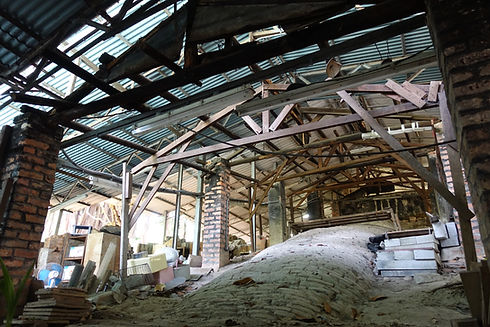

history
Hong Kong's only complete and intact dragon kiln
Kilns are "ovens" used for firing ceramics, and dragon kilns were invented in the Ming dynasty, then become prevalent in Shiwan and other parts of Southern China.
The Castle Peak Dragon Kiln is a 20-metre long, and located in present-day Tuen Mun in Hong Kong's New Territories. It was constructed in the 1940s and in continuous use until the 80s. It fired functional ceramics including wine jars (五加皮酒樽), drainage pipes (水渠) and traditional soup pots (沙煲), as well as valuable works of ceramic sculptures and art pieces.
The Castle Peak Pottery Kiln is the only complete and intact dragon kiln in Hong Kong.
歷史軌跡


40s
1940s The Castle Peak pottery kiln is founded by merchant Szeto Nu Tao.
1949 Kiln expert Leung Sum migrates to Hong Kong from Shiwan, Guangdong.
歷史軌跡



50s
1950s Leung Sum sets up “Kung Hop Pottery Kiln,” (“Workers’ Kiln”).
1951 Szeto steps away from the business, and Leung Sum takes over operation of the kiln as foreman, and establishes “Kung Hop Pottery Kiln,” (“Workers’ Kiln”) producing a wide range of household ceramic ware.
歷史軌跡
60s
1960s Kiln is fired once a month. As electricity came to the kiln in the late 60s, everything before then was made by only by hand. Some machinery was eventually added to support the hand made process.
1966 Artist Chan Chung Kwong starts living at the kiln to study ceramic art, staying for 3 years.
1967 Leung Sum, Chan Chung Kong and artist Chan Ping Tim establish the Hong Kong Ceramic Arts Studio, selling ceramic supplies like clay, glazes and other raw materials. This business runs to this day.
歷史軌跡


70s
1970s In the face of cheaper ceramic imports from mainland China, output is reduced.
Eary 1970s The kiln is fired every 1 or 2 months. Due to policy at the time, mainland China could not produce vessels used in folk rituals, an area of production that the Dragon Kiln exploited.
Till late 1970s The Dragon Kiln faces fierce competition as Chinese market continues to open up. With production costs also rising, operation become more and more difficult.
歷史軌跡



80s
1980s
Production stops at the Dragon Kiln, government proposes conservation, but plans do not become reality.
Early 1980s - Government acquires kiln site as part of Tuen Mun New Town development. The kiln faces demolition.
1982 Executive Secretary of the Antiquities and Monuments Office Dr. Solomon Bard visits the kiln, and lobbies other government departments to preserve the kiln and re-fashion it as a “Working Museum.” The governor’s wife Lady Pamela Youde visits the kiln.
1985 A test firing takes place at the kiln on May 26. This becomes the last time the kiln is fired.
1988 The conservation plan comes to a halt. Leung Sum passes away in June. His son Leung Pak Chuen continues living at the kiln.
歷史軌跡


90年代
1993 A typhoon destroys the kiln’s wooden roof on, prompting Leung Pak Chuen to build a temporary cover.
1997 Informed of the damage by Leung Pak Chuen, the government installs a new protective metal roof over the kiln, which stands to this day.
歷史軌跡
2000年代
1993
颱風襲港吹毀原有木製窯棚,梁栢泉搭建臨時窯棚。
1997
政府因應梁栢泉要求派員興建金屬窯棚,該窯棚一直使用至今。
歷史軌跡


2012 till now
The kiln is rated a Grade III historical site, but is simultaneously threatened by demolition. The Hong Kong Dragon Kiln Concern Group is formed.
2012 The Antiquities and Monuments Office evaluates the dragon kiln, and rates it a Site of Archaeological Interest in Hong Kong.
2014 The Antiquities Advisory Bureau gives the kiln a Grade 3 Historical Site grading on March 4.
2016 The Government proposes to redevelop the kiln site and surrounding area into residential housing.
2017 The Hong Kong Dragon Kiln Concern Group is established in July with the goal to preserve the kiln and raise public awareness of its significance.
2019 Disused school by the dragon kiln is demolished, and construction begins, putting the kiln under threat.

